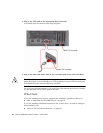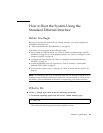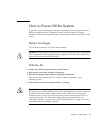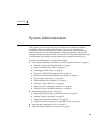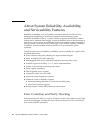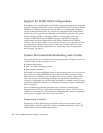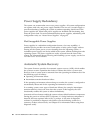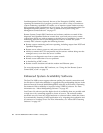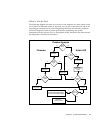
66 Sun Fire 280R Server Owner’s Guide • January 2001
Support for RAID Disk Configurations
Redundant arrays of independent disks (RAID) storage configurations are supported
using PCI adapter cards and the system’s external UltraSCSI or FC-AL ports. Solstice
DiskSuite or VERITAS software provides the ability to configure disk storage in a
variety of different RAID levels. You choose the appropriate RAID configuration
based on the price, performance, reliability, and availability goals for your system.
RAID 0 (striping), RAID 1 (mirroring), RAID 0+1 (striping plus mirroring—
sometimes called RAID 10), and RAID 5 (striping with interleaved parity)
configurations can all be implemented using Solstice DiskSuite and VERITAS
software. You can also configure one or more drives to serve as a hot spare to fill in
automatically for a defective array drive in the event of a disk failure. For more
information about RAID configurations, see “About Disk Array Configurations
and Concepts” on page 87.
System Environmental Monitoring and Control
The system features an environmental monitoring subsystem designed to warn you
of threats to the system’s operation, such as:
■ Extreme temperatures
■ Lack of air flow through the system
■ Power supply problems
Monitoring and control capabilities reside at the operating system level as well as in
the system’s on-board flash PROM firmware and in the Remote System Control
(RSC) firmware. In addition, you can monitor the system remotely using the RSC
card. This ensures that monitoring capabilities are operational both locally and
remotely (if configured), even if the system has halted or is unable to boot. For more
information about RSC software, see “Using the Sun Remote System Control (RSC)
Card” on page 74.
The environmental monitoring subsystem uses an industry-standard Inter-
Integrated Circuit (I
2
C) bus implemented throughout the system. The I
2
C bus is a
simple two-wire serial bus, used to allow the monitoring and control of temperature
sensors, power supplies, disk drives, and status LEDs.
Temperature Controls
Temperature sensors (thermistors) are located on the system’s Remote System
Control (RSC) card and on the CPU modules, and allow monitoring of each CPU
module and the system ambient temperature.



